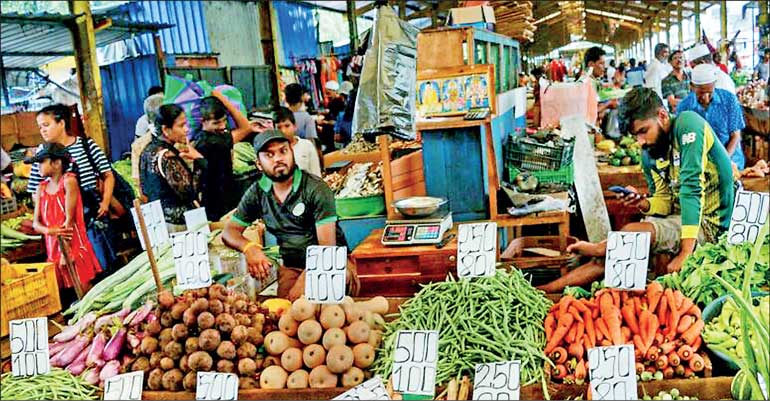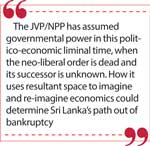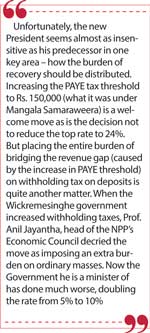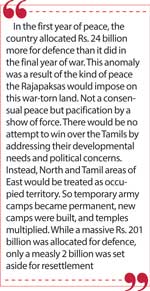Monday Apr 28, 2025
Monday Apr 28, 2025
Wednesday, 1 January 2025 00:40 - - {{hitsCtrl.values.hits}}

The dilemma is simple. If taxes are reduced for one set of people, there will have to be a corresponding tax increase affecting another set of people
“History, despite its wrenching pain,
Cannot be unlived, but if faced
With courage, need not be lived again”.
– Maya Angelou (On the Pulse of Morning: An Inaugural Poem)
By Tisaranee Gunasekara
The Kitchen Debate was an impromptu set of exchanges (via interpreters) between US vice president Richard Nixon and Soviet premier Nikita Khrushchev, on the relative merits of capitalism and socialism. The two leaders were attending the 1959 American National Exhibition in Moscow. Their exchange took place inside a replica of a suburban American kitchen complete with all the mod-cons which would soon become staples of American middle class life.
 Nixon displayed each consumer durable to his counterpart – and to the world beyond – with pride, as proof that American capitalism was better able to provide ordinary people with a good life. “Our steel workers, as you know, are on strike,” he said at one point. “But any steel worker could buy this house.” Khrushchev countered by predicting that the USSR would overtake the US in seven years and Nixon’s grandchildren would live under socialism.
Nixon displayed each consumer durable to his counterpart – and to the world beyond – with pride, as proof that American capitalism was better able to provide ordinary people with a good life. “Our steel workers, as you know, are on strike,” he said at one point. “But any steel worker could buy this house.” Khrushchev countered by predicting that the USSR would overtake the US in seven years and Nixon’s grandchildren would live under socialism.
History worked otherwise. Thirty years after the Kitchen Debate, Berlin Wall fell; in another two the Soviet Union ceased to exist.
Capitalism beat socialism by borrowing liberally from the socio-economic arsenal of socialism. As US historian and Cambridge professor Gary Gerstle points out, “The fear of communism made possible the class compromise between capital and labour that underwrote the New Deal. It made possible similar class compromises in many social democracies in Europe after the Second World War.” This ‘grand bargain’ spread “America’s wealth across a much greater swath of the country’s workers and consumers, thus generating and sustaining higher levels of demand and, across the next two decades, an era of impressive affluence” (The Rise and Fall of the Neoliberal Order). High progressive taxation was a key driver of this transformation. In 1935, for instance, the marginal tax rate on the wealthiest Americans was set at 75%.
 So Nixon’s boast to Khrushchev came true. Western welfare states ensured higher living and working conditions to their own working classes than what prevailed in the Eastern Bloc. As Eric Hobsbawm pointed out, “It is one of the ironies of this strange century that the most lasting result of the October Revolution, whose object was the global overthrow of capitalism, was to save its antagonist both in war and in peace – that is to say by providing it with the incentive, fear, to reform itself after the Second World War...” (The Age of Extremes).
So Nixon’s boast to Khrushchev came true. Western welfare states ensured higher living and working conditions to their own working classes than what prevailed in the Eastern Bloc. As Eric Hobsbawm pointed out, “It is one of the ironies of this strange century that the most lasting result of the October Revolution, whose object was the global overthrow of capitalism, was to save its antagonist both in war and in peace – that is to say by providing it with the incentive, fear, to reform itself after the Second World War...” (The Age of Extremes).
With the fall of the Berlin Wall and the passing of the Soviet Union, the political raison d’être for the ‘grand bargain’ vanished. Economic neo-liberalism became dominant globally. A key component of this economic counter-reformation was the return to certain ideas, once abandoned as unethical and damaging/destabilising – such as the belief of inequality being the driving force of capitalist growth. In the post-socialist world, the worsening chasm between the rich and the poor ceased being seen as undesirable, or dangerous. Denuding public welfare and anti-Robin Hood tax policies became synonymous with ‘good economics’. China – and Vietnam – survived the implosion partly by remaking its economy along capitalist lines. A communist party flying the red banner and paying lip service to Marx presided over a system tolerant towards extreme inequality and intolerant towards worker rights.
35 years after the fall of the Berlin Wall, the Neo-liberal Order too is dead. Nothing symbolises this demise more than the change in the IMF, guardian and driver of neo-liberal orthodoxy not so long ago. The IMF’s attitudinal transformation can best be understood by its cautious acceptance of such ‘radical’ ideas as Universal Basic Income (UBI) and its unequivocal embrace of progressive taxation. “For years, politicians and economists alike have been arguing that higher taxes for the top 1% earners, as tax theory suggest there should be, would be bad for growth… Empirical results do not support this argument, at least for levels of progressivity that are not excessive… Conclusion: Higher taxes for the rich will reduce inequality without hitting growth. Now it seems that it’s time for the politicians to start translating this into policy as soon as possible” (IMF Fiscal Monitor). The Bretton Woods twin is putting this prescription into practice in Sri Lanka. Colombo has agreed to introduce a property tax and a wealth transfer tax (inheritance tax) in, as part of its IMF program.
 The JVP/NPP has assumed governmental power in this politico-economic liminal time, when the neo-liberal order is dead and its successor is unknown. How it uses resultant space to imagine and re-imagine economics could determine Sri Lanka’s path out of bankruptcy.
The JVP/NPP has assumed governmental power in this politico-economic liminal time, when the neo-liberal order is dead and its successor is unknown. How it uses resultant space to imagine and re-imagine economics could determine Sri Lanka’s path out of bankruptcy.
Lessons of memory
In 2011, two Lankan fighter planes collided mid-air. The Israeli-made Kfir jets were not on combat duty, for the war was over. They collided while practicing for a fly past to commemorate the 60th anniversary of the Lankan air force. The weeklong celebration was to begin with a ceremony presided over by then president Mahinda Rajapaksa. Post-war, the only real use for much of our military hardware has been as ego-boosters, to feature in drive-pasts and fly-pasts before civilian and military leaders. Yet, in that same year, Sri Lanka bought 14 Russian Mi-17 military helicopters. In classic Rajapaksa fashion, the deal was shrouded in secrecy. According to a Reuters report, the general director of Russia’s state-owned arms exporter Rosoboronexport said the helicopters were delivered while spokesmen for the defence ministry and the air force claimed to be ignorant of the deal!
In 2021, as the country was teetering on the edge of bankruptcy, the Gotabaya Rajapaksa administration decided to upgrade Lankan air force’s aged Kfir fleet. An agreement for $ 49 billion was signed with the manufacturer, Israel Aerospace Industries. The plan had been under consideration for a while, but delayed due to budgetary constraints. Unfortunately, constraints (budgetary or otherwise) was not a word in Gotabaya Rajapaksa’s rather limited lexicon. So 9.8billion rupees was pledged to upgrade four single-seater jets and a trainer. Commenting on this, the NPP cabinet spokesman admitted to the problematic nature of the deal as the jets were produced in 1970’s and upgrading such old hardware makes no sense.
 With such wanton waste of scarce resources, little wonder we went bankrupt.
With such wanton waste of scarce resources, little wonder we went bankrupt.
Officially, Sri Lanka has emerged from bankruptcy. Contrary to popular opinion, most of the credit for this relatively fast recovery should go to Ranil Wickremesinghe. The rest of the credit belongs to Anura Kumara Dissanayake for not doing a Gota 2 on the IMF deal and debt renegotiations.
Unfortunately, the new President seems almost as insensitive as his predecessor in one key area – how the burden of recovery should be distributed. Increasing the PAYE tax threshold to Rs. 150,000 (what it was under Mangala Samaraweera) is a welcome move as is the decision not to reduce the top rate to 24%. But placing the entire burden of bridging the revenue gap (caused by the increase in PAYE threshold) on withholding tax on deposits is quite another matter. When the Wickremesinghe government increased withholding taxes, Prof. Anil Jayantha, head of the NPP’s Economic Council decried the move as imposing an extra burden on ordinary masses. Now the Government he is a minister of has done much worse, doubling the rate from 5% to 10%.
This could have an almost as bad an impact on the lower middle class (especially retirees) as President Wickremesinghe’s 2023 electricity hike. That effect could have been mitigated had the Government introduced a threshold to shield small deposit holders. But such considerations seem to be beyond the mental ken of the new Government as well.
The dilemma is simple. If taxes are reduced for one set of people, there will have to be a corresponding tax increase affecting another set of people. No Government can cut direct taxes, maintain high military expenditure, keep white elephants like Sri Lankan going, manage the debt burden, and keep the economy afloat, without imposing huge burdens on ordinary masses.
The NPP/JVP came to power making contradictory promises to different interest groups. Its manifesto was more like a wish-list than a plan for action. Suffering from a paucity of practical ideas, the new Government seems to be resorting to such senseless (and faux populist) measures as imposing price controls on tinned fish. Surely, the relevant minister could be better employed resolving the rice crisis before opening a new – and a far from necessary – front? There is a difference between new and amateur; the first is refreshing, the second potentially disastrous. Hopefully, the NPP Government will figure out that difference, before Sri Lanka succumbs to the globally surging ethno-national-populist wave.
Budgetary paths
 The first post-war Budget was presented in 2010 by President Mahinda Rajapaksa in his capacity as Finance Minister.
The first post-war Budget was presented in 2010 by President Mahinda Rajapaksa in his capacity as Finance Minister.
In 2009, the year the war was at its most intense and critical, Sri Lanka’s defence allocation was Rs. 177 billion. In the first year of peace, Sri Lanka’s defence allocation was Rs. 201 billion. Normally, defence expenditure increases in times of war and decreases (or stabilises) once peace dawns. Sri Lanka became the antithesis of this norm; in the first year of peace, the country allocated Rs. 24 billion more for defence than it did in the final year of war.
This anomaly was a result of the kind of peace the Rajapaksas would impose on this war-torn land. Not a consensual peace but pacification by a show of force. There would be no attempt to win over the Tamils by addressing their developmental needs and political concerns. Instead, North and Tamil areas of East would be treated as occupied territory. So temporary army camps became permanent, new camps were built, and temples multiplied. While a massive Rs. 201 billion was allocated for defence, only a measly 2 billion was set aside for resettlement.
Tamils were not the only victims of this deeply flawed prioritisation. Rapidly increasing defence expenditure consumed the much-awaited peace dividend as well, something the Sinhalese were promised and looked forward to during the final Eelam War. Low financial importance was accorded to such key areas as education and health. For instance, in the path-making 2010 Budget, education (including higher education) was allocated a mere Rs. 46 billion (around 18% of defence expenditure), health an allocation of Rs. 52 billion (about 25% of defence expenditure). Meanwhile, indirect taxes continued to increase, leading to a hike in cost of living and a drop in living standards.
As hopes of post-war prosperity faded, the Rajapaksa magic lost its potency. According to the CPA’s Top Line Survey: Democracy in Post-War Sri Lanka, 50.5% of Lankans and 45.4% of Sinhalese thought that national economic situation was somewhat bad/very bad. Of this category the absolute majority (70.5% of Lankans and 66.6% of Sinhalese) believed that the Government was responsible for this unhappy state of affairs. The Rajapaksas thought they had the situation in hand with the ‘Muslim enemy’, but that calculation misfired. Their defeat of January 2015 was foretold by that 2013 CPA survey result.
The NPP Government, with its national mandate, has a chance to undo this and other Rajapaksa errors. Whether it has the necessary vision to do so would become clearer with President Dissanayake’s first Budget.
Whatever the nature of the Budget, the NPP/JVP is bound to win the upcoming local government and provincial council elections – as did the Rajapaksas, from 2010 to 2014. But if the Government fails to deliver a modicum of relief to the masses in 2025, those victories will result not from growing or even stable popularity, but from greater disenchantment with the main Opposition. As the hype generated by the NPP’s victory erodes into sullen dissatisfaction, a vacuum will be created in the political arena, with a growing segment of the electorate looking for the next saviour.
The neoliberal order might be dead; but there’s no global movement capable of filling the resultant vacuum. Across much of the world, the left is in disarray and non-racist forces are on the back foot, lacking an overarching political message and a compelling economic vision. The leading contender for the next global ‘ideas’ hegemon is right wing ethno-religious populism. It has world’s most populous democracy, India, in its clutch and has emerged victorious in the world’s most powerful democracy, the US.
Sri Lanka managed to buck this global trend in 2024. But 2029 might be another matter. For the NPP’s much celebrated 6.8 million constitutes is, to a large extent, the same as Gotabaya Rajapaksa’s 6.9 million. If the new Government fails to satisfy, and the non-racist Opposition (led by the equally anti-inspirational Sajith Premadasa and Ranil Wickremesinghe) continues to stagnate, the pendulum is likely to swing in the direction of the Rajapaksas or some other saviour of the ethno-religious populist brand. Just a few months into the NPP’s historic Presidential and Parliamentary victories, such a possibility might seem a very distant prospect. But if the road is in the making, the destination is only a matter of time.
Discover Kapruka, the leading online shopping platform in Sri Lanka, where you can conveniently send Gifts and Flowers to your loved ones for any event including Valentine ’s Day. Explore a wide range of popular Shopping Categories on Kapruka, including Toys, Groceries, Electronics, Birthday Cakes, Fruits, Chocolates, Flower Bouquets, Clothing, Watches, Lingerie, Gift Sets and Jewellery. Also if you’re interested in selling with Kapruka, Partner Central by Kapruka is the best solution to start with. Moreover, through Kapruka Global Shop, you can also enjoy the convenience of purchasing products from renowned platforms like Amazon and eBay and have them delivered to Sri Lanka.
Discover Kapruka, the leading online shopping platform in Sri Lanka, where you can conveniently send Gifts and Flowers to your loved ones for any event including Valentine ’s Day. Explore a wide range of popular Shopping Categories on Kapruka, including Toys, Groceries, Electronics, Birthday Cakes, Fruits, Chocolates, Flower Bouquets, Clothing, Watches, Lingerie, Gift Sets and Jewellery. Also if you’re interested in selling with Kapruka, Partner Central by Kapruka is the best solution to start with. Moreover, through Kapruka Global Shop, you can also enjoy the convenience of purchasing products from renowned platforms like Amazon and eBay and have them delivered to Sri Lanka.